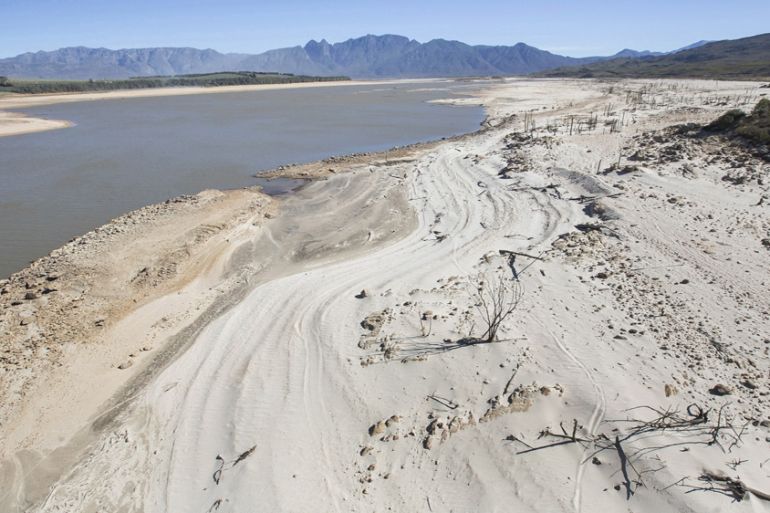Cape Town confronts looming ‘Day Zero’ water crisis
Taps in the drought-hit South African city could be turned off by April 21.

Like many others in Cape Town, Sandra Dickson has no other option but to get creative.
“We catch water from our showers in buckets, and throw it into our toilets,” Dickson, who has been living in the South African city for the last 24 years, told Al Jazeera.
Keep reading
list of 4 itemsPhotos: Heartbreak in Zimbabwe park – Elephants’ desperate hunt for water
Photos: Natural disasters that plagued the world in 2023
‘Everything is dead’: How record drought is wreaking havoc on the Amazon
“We’re doing all sorts of things,” she said. “People are even catching water off their roofs.”
The reason for this?
Within 100 days, almost all of the taps in Cape Town could be turned off.
In the grip of a three-year-long drought, the city is predicted to reach “Day Zero” – when its water-supplying dams sink below 13.5 percent of combined capacity – on April 21.
The crisis, principally caused by a lack of rainfall throughout the entire Western Cape province, has led city officials to impose “level six” restrictions on Cape Town’s some 3.7 million people.
With dam levels currently below 30 percent, local authorities have capped water usage at 87 litres a person a day, in what have been described as the most severe restrictions of this kind ever put in place.
A history of abundance
For centuries, South Africa‘s southwest coast has been known for its abundant natural water supplies, generated by the heavy winter rains traditionally characteristic of the region.
Before Europeans colonised the area to create a refreshment stop for sailors in 1652, the land suspended between Table Mountain and the South Atlantic Ocean was referred to by the indigenous Khoi people as “Camissa”, meaning “Place of Sweet Waters”.
The city sits in a geographical bowl, making it a natural catchment area for the seasonal rains which have been relied upon to fill the dams that, since their construction in the late 19th and early 20th century, have held Cape Town’s water supply.
![Cape Town sits in a natural bowl, making it a catchment area for the winter rains which have traditionally fallen on the city [Obed Zilwa/AP]](/wp-content/uploads/2018/01/2a682bcc4d8c4b53af31453548c51383_18.jpeg)
In years of average rainfall, for example, up to three times as much of the water used annually by the city falls in the area, ensuring a plentiful supply, according to Kevin Winter, a senior lecturer in environmental science at the University of Cape Town.
But, now, such abundance is no more, as a result of later, less frequent, seasonal rains, which have caused water levels in the dams to fall below 29 percent of combined capacity.
“It is raining, but not sufficiently to fill up our dams,” said Winter.
“As a winter rainfall region, we would [traditionally] expect rainfall to start somewhere around April, but that’s no longer the case, it comes a whole lot later at the end of June, or in early July, if we are lucky.”
According to Winter, up to three years’ worth of seasonal rainfall would be required to bring the dams’ water levels to pre-2015 standards.
“We are experiencing a rapid change in our weather patterns, which is increasingly evident of a climate change … There’s been a very definite, sharp decline in rainfall levels in recent years,” he said.
Bridgetti Lim Bandi, founder of the website capetownwatercrisis.com and lifelong resident of the city, said that Cape Town’s rainfall pattern has changed dramatically within the last two decades.
“We don’t have a traditional Cape Town winter any more,” she told Al Jazeera.
“It’s not something new, although the City of Cape Town seems to be passing it as such.”
Attempts to avert a crisis
In response to the dwindling water supplies, city officials are pursuing a number of solutions in a bid to avert “Day Zero”, and add to the levels of water in the dams that store Cape Town’s water supply.
Winter said the environmental conditions had forced “new decision-making to occur”, arguing, however, that the city’s longer-term planning “has been quite weak in bringing about a more integrated approach to water management”, which has traditionally relied on surface water.
“Ninety-eight percent of Cape Town’s water supply has come from surface water, and we haven’t [historically] explored a range of other water alternatives,” said Winter.
But Cape Town Mayor Patricia de Lille said the city had initiated programmes to top up levels in the dams using non-surface water sources and techniques such as drilling into aquifers, desalination of seawater and water recycling [from wastewater].
“The city is going out of its way and working beyond its mandate to bring additional water online from various sources,” she told Al Jazeera.
“We implemented water restrictions long before we were required to do so by the National Department and had it not been for our … demand management and conservation plan, the city would probably have run out of water by now.”
Officials have kept water demand flat, despite a population growth of 30 percent in the last 15 years alone, added de Lille.
![Patricia de Lille (R) imposed level six water restrictions on Cape Town on January 1 [Rodger Bosch/AFP]](/wp-content/uploads/2018/01/d2da98257d454a9fbdccb87b22702836_18.jpeg)
‘Day Zero’
If Cape Town does reach “Day Zero”, authorities will turn off the taps – apart from in the poorest neighbourhoods – and install some 200 water collection sites across the city, according to Cape Town’s water shortages disaster plan.
Citizens will then be able to collect approximately 25 litres a person a day from the sites, guarded by police, in line with a World Health Organization recommendation.
No strategy, however, can solve the pressing problem of a lack of precipitation, said Winter
“The combination of interventions and current water demand levels may enable the city to avoid ‘Day Zero’ … But, without rainfall, in the next few months we could be in serious, serious trouble.”